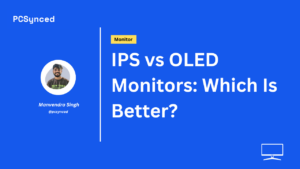About The Article:
- Response time is the time it takes for a monitor to display an image after receiving a signal from the computer. It is measured in milliseconds (ms).
- A lower response time is better, resulting in smoother motion and less lag.
- When choosing a monitor, it is important to consider your needs and budget. If you are a gamer or someone who does a lot of video editing, you will want a monitor with a fast response time and high refresh rate.
Written By – Manvendra Singh
In computer monitors, several key factors determine the quality of your viewing experience.
One of these is the monitor’s response time.
But what exactly is response time, and why is it so important?
In this article, we’ll learn about monitor response time, its significance, and what constitutes a good response time for different types of uses.
Quick Answer:
Monitor response time refers to how quickly a display can change pixels, impacting clarity in fast-moving visuals. In 2023, understanding and optimizing this metric is crucial for gaming and professional applications.

What is Monitor Response Time?
Monitor response time, often called response time, measures how quickly a pixel on your monitor can change colours.
It’s usually measured in milliseconds (ms), representing the time it takes for a pixel to change from one shade of grey to another (also known as GTG or grey-to-grey response time).
In simpler terms, response time is essentially the speed at which your monitor’s screen updates.
A lower response time means faster and smoother changes, reducing the chances of ghosting or motion blur in fast-paced visuals.
Why is Response Time Important?
The importance of response time becomes evident when dealing with fast-moving images or scenes, such as in video games or action-packed movies.
A monitor with a slow response time may result in blurry images or a phenomenon known as ghosting.
Ghosting occurs when the previous image displayed on the screen can still be faintly seen even after the picture changes.
A Monitor with a fast response time can keep up with rapid changes, resulting in sharper images and a smoother overall visual experience.
This is particularly crucial in competitive gaming, where every millisecond counts.
Ideal Response Times for Different Uses
1. Gaming
A lower response time is ideal for gaming, particularly fast-paced or competitive games.
A response time of 1 ms to 2 ms is considered excellent for gaming monitors.
This ensures smooth gameplay and reduces motion blur and ghosting, providing a competitive edge in reaction-based games.
2. Professional Work
A balance between color accuracy and response time is needed for professional work such as graphic design, video editing, or 3D modelling.
While a fast response time is still beneficial, it’s not as crucial as gaming.
A response time of 5ms to 8ms is generally sufficient for these tasks.
3. General Use
A higher response time is typically acceptable for general use, such as browsing the web, watching videos, or working on documents.
A response time of up to 10ms should provide a smooth enough experience for these activities.
Conclusion
In conclusion, monitor response time is crucial to your viewing experience’s quality.
While a lower response time is generally better, the ideal response time can vary depending on what you primarily use your monitor for.
Whether you’re a gamer seeking the smoothest visuals, a professional needing a balance between speed and accuracy, or a casual user looking for a comfortable viewing experience.
Understanding response time and refresh rate can help you decide when choosing a monitor.








